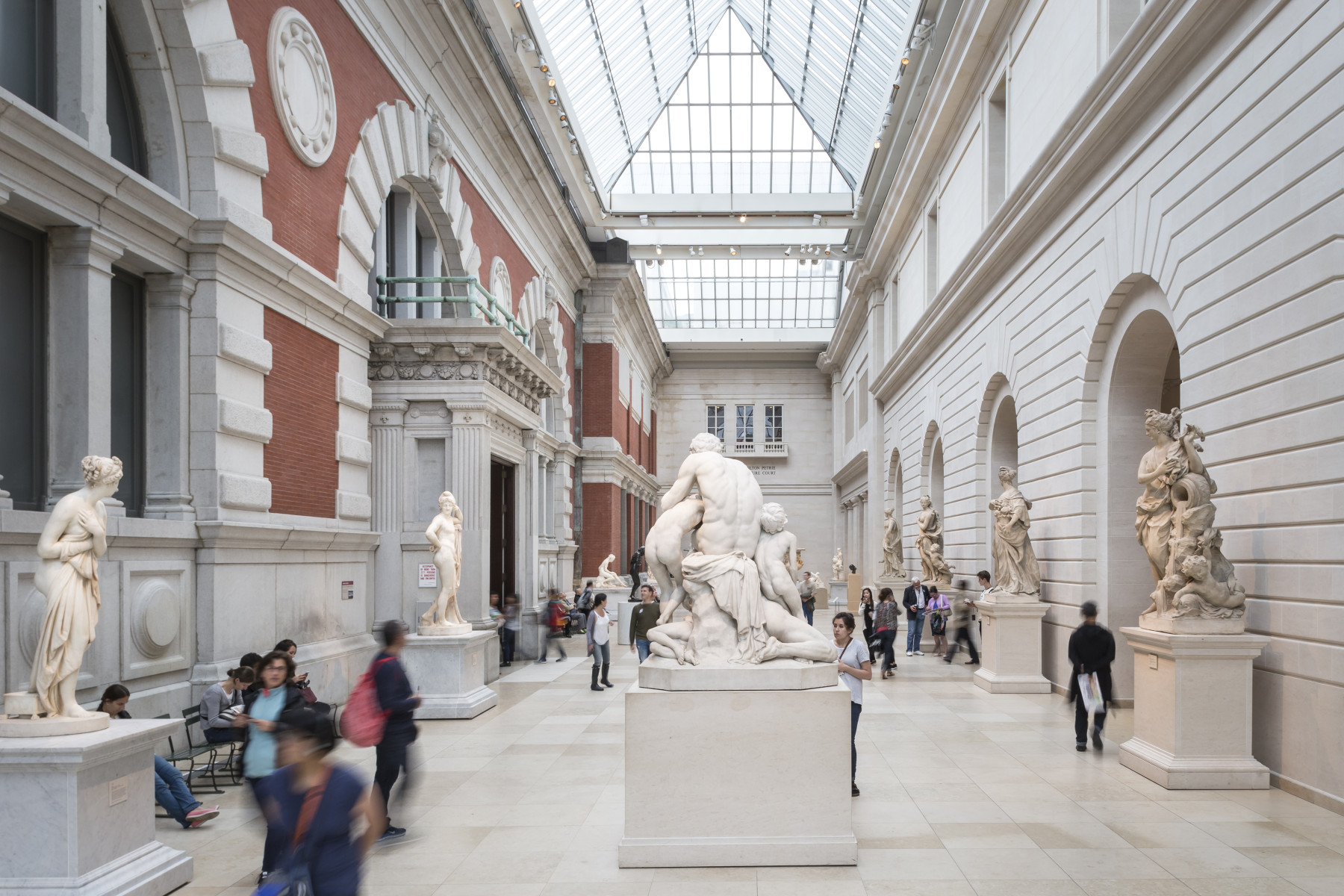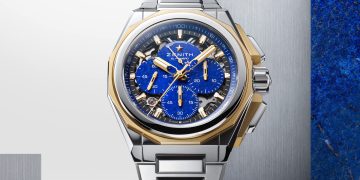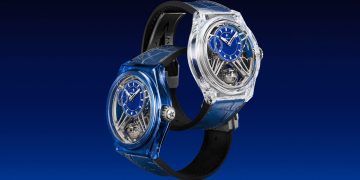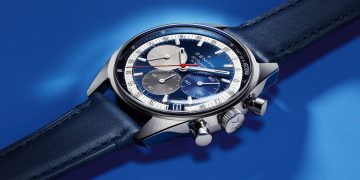Source: Images and content by Vacheron Constantin
http://content.presspage.com/uploads/1999/fe5e48e1-9500-489b-931f-9f8e50f4df43/500_themetfifthavecarrollandmiltonpetrieeuropeansculpture-copybrettbeyer-courtesyofthemet.jpg?10000
- The partnership between Vacheron Constantin and The Metropolitan Museum of Art (The MET) was established in 2023 with the long-term vision of safeguarding and passing on knowledge and expertise.
- The ‘Masterpiece on your Wrist’ program offers Vacheron Constantin’s clients the possibility of creating a single-piece edition Les Cabinotiers watch, the dial of which will feature an enamel reproduction of an artwork chosen by the client. The program now offers works from The MET’s collection, such as masterpieces by Claude Monet, Winslow Homer, Vincent van Gogh, and Augustus Saint-Gaudens.
- The ‘Masterpiece on your Wrist’ program offers clients a unique experience when commissioning their piece unique, including a private tour of The MET in the company of its expert curators, as well as a visit to Vacheron Constantin’s Manufacture in Geneva.
Ever since its founding in 1755, a deep commitment to the arts has been at the core of Vacheron Constantin and remains integral today. The ongoing partnership with The Metropolitan Museum of Art is the latest way in which Vacheron Constantin continues to support, engage, and learn from the Arts community.
A long-term Partnership
The partnership between Vacheron Constantin and The Metropolitan Museum of Art (The MET), launched in 2023, is rooted in a shared commitment to safeguarding and passing on knowledge and expertise. Both institutions individually have extensive histories of conservatorship in artistic know-how and craft, and together seek to share in this commitment to the arts. For Louis Ferla, CEO of Vacheron Constantin, “the quest for excellence is a constant challenge in which we never stop learning.” This multi-year partnership will focus on the values shared between the two institutions and will support combined ideas and efforts to engage the artistic and creative community. Continued learning, and a support of the transmission of knowledge from master to apprentice, have been at the core of Vacheron Constantin since 1755.
Max Hollein, The MET’s Marina Kellen French Director and CEO, has shared: “We are delighted to partner with Vacheron Constantin and are grateful for their support of The MET’s mission, which aligns with the esteemed watchmaker’s own longstanding efforts to celebrate creativity and preserve artistic traditions. We look forward to collaborating on a number of unique projects that build on our mutual commitment to education and the arts.”
Vacheron Constantin and The MET’s partnership will entail a variety of mission-driven projects, including an artist-in-residency program and other educational initiatives, to be shared at a later date. The first project to be unveiled is the extension of the ‘Masterpiece on your Wrist’ program.
The Masterpiece on your Wrist Program
Initially launched in 2019, the ‘Masterpiece on your Wrist’ program offers connoisseurs the unique opportunity to realize a bespoke, single piece edition watch, featuring an enamel dial reproduction of a masterwork housed in the world’s preeminent museums. The partnership with The Metropolitan Museum of Art now broadens this offering, bringing iconic and beloved pieces into the program’s catalog. To fully illustrate this vision, Vacheron Constantin and The MET have already identified a number of exceptional pieces which can be realized in the ‘Masterpiece on your Wrist’ including paintings such as Wheat Field with Cypresses by Vincent van Gogh, Bridge over a Pond of Water Lilies by Claude Monet and Northeaster by Winslow Homer or sculptures such as Diana by Augustus Saint-Gaudens, are offered.
As a part of the ‘Masterpiece on your Wrist’ experience, the commissioning client will have the opportunity to experience a private tour of The MET in the company of its experts and curators, to guide selection of their Masterwork, as well as a visit to Vacheron Constantin’s Manufacture in Geneva to meet the master watchmakers and artisans who will undertake the project. The culmination of this process will result in a piece unique watch, accompanied by a certificate of authenticity from both the museum and Vacheron Constantin, reflecting the taste and interests of its commissioner and offering a daily view of a masterpiece.
Métiers d’Art– Miniature Enamel Painting
Miniature Enamel Painting is an exceedingly rare craft, mastered by only a select few artisans worldwide. This technique consists of hand-painting in minutia a desired artwork or motif onto a base-layer of baked enamel. Applied in individual thin layers by color, the paint is fixed in place by successive firings. Once the painting is complete, the artisan protects the work with a transparent enamel flux to give it both brilliance and depth. Unlike other techniques, Miniature Painting is perfect for reproducing dramatic details, movement and colors due to its unique ability to imitate the brushstrokes and impasto depth of classical paintings.
Miniature Enamel Painting is the perfect technique for realizing masterworks such as: Bridge over a Pond of Water Lilies by Claude Monet (1899), Northeaster by Winslow Homer (1895 reworked by 1901), and Wheat Field with Cypresses by Vincent van Gogh (1889).
Métiers d’Art – Grisaille Enameling
The Grisaille enameling is a monochromatic technique often employed due to its unrivaled ability to suggest depth, luminosity and dimensionality. Grisaille is the perfect technique to create the illusion of sculpture, especially relief, due to the shading achieved in the process. Grisaille begins with a dark enamel base, usually black, as a background upon which the master artisan builds up translucent layers of Limoges white – a pasty white enamel – to obtain varying shades of grey. Each successive layer builds up a chiaroscuro effect, the representation of light and shadow as they define three-dimensional objects, to suggest to the viewer an object in space.
Grisaille enameling is the perfect technique for reproducing masterworks such as: Diana by Augustus Saint-Gaudens (1893-94).
Summary
Vacheron Constantin offers their ‘Masterpiece on the Wrist’ program in partnership with New York’s prestigious Metropolitan Museum of Art. This alliance is based on common values of safeguarding and passing on knowledge dedicated to creativity and innovation. Their joint emphasis on artistic and cultural heritage encourages the sharing of knowledge in the pursuit of excellence. The MET and Vacheron Constantin will continue developing a series of joint projects designed to showcase their respective rich heritages and their ability to keep cultural legacies alive for future generations.
Calibres Available / Technical Data
Calibre
2755 TMR
Developed and manufactured by Vacheron Constantin Mechanical, manual-winding
33.9 mm diameter, 6.1 mm thick
Approximately 58 hours of power reserve
2.5 Hz (18,00 vibrations per hour)
471 components
40 jewels
Hallmark of Geneva certified timepieces
Minute Repeater, Power Reserve, Tourbillon, Hours, minutes and small seconds on Tourbillon
The manual-winding 2755 TMR movement, launched in 2017, combines the musical charm of a minute repeater with the timekeeping precision of a Maltese cross-shaped tourbillon regulator. Designed to compensate for the effects of the Earth’s gravity, this mechanism operates at a low frequency of 2.5 Hz (18,000 vibrations per hour). This enables its complexity to be fully appreciated – especially as it is the only mechanical element visible from the front, with the 58-hour power reserve displayed by a hand on the back of the watch. The only sign of the minute repeater’s presence is the slidepiece on the case middle.
To create this on-demand striking mechanism, one of the most delicate horological complications due to its melodiously audible nature, Vacheron Constantin’s engineers and master watchmakers drew inspiration from the work carried out on the La Tour de l’Île anniversary watch in 2005 and notably its strike governor. This system enables the duration of the musical sequences to be perfectly timed in order to obtain a distinct and harmonious sound from the notes played for the hours, quarters and minutes by the hammers striking the two circular gongs. Calibre 2755 TMR features High Watchmaking finishing including meticulously hand-chamfered bridges adorned with a Côtes de Genève pattern, a circular-grained mainplate and a beautifully rounded-off tourbillon carriage bar.
Calibre
1731
Developed and manufactured by Vacheron Constantin Mechanical, manual-winding
32.8 mm diameter, 3.9 mm thick
Approximately 65 hours of power reserve
3 Hz (21,600 vibrations per hour)
265 components
36 jewels
Hallmark of Geneva certified timepieces
Minute Repeater, Hours and minutes
The In-house Calibre 1731, named after the year Jean-Marc Vacheron was born, offers extreme thinness for a minute repeater movement. At only 3.90 mm thick, it is nevertheless equipped with a barrel ensuring an impressive 65-hour power reserve. It took four years to solve the conundrum of how to create a minute repeater movement combining slenderness, pure acoustics, aesthetic elegance, reliability and robustness. Nor is the technical prowess confined to the ultra-thin challenge, since Calibre 1731 is also equipped with a completely silent flying strike governor (unlike conventional pallet lever-type governors), whose role is to regulate the rate at which the hammers strike the gongs. Great attention was devoted to acoustics, the true reason for being of a minute repeater. To obtain a crystal-clear and perfectly harmonious sound, the gongs are not only linked to the case middle to amplify the sound, but also superimposed rather than aligned side by side.
Calibre
2460 SC
Developed and manufactured by Vacheron Constantin
Mechanical, self-winding
26.2 mm diameter, 3.6 mm thick
22K pink gold oscillating weight with The MET façade engraving
Approximately 40 hours of power reserve
4 Hz (28,800 vibrations per hour)
182 components
27 jewels
Hallmark of Geneva certified timepieces
Hours, minutes and central seconds
……………………………………..
The Metropolitan Museum of Art
The Metropolitan Museum of Art was founded in 1870 by a group of American citizens—businessmen and financiers as well as leading artists and thinkers of the day—who wanted to create a museum to bring art and art education to the American people. Today, The MET displays tens of thousands of objects covering 5,000 years of art from around the world for everyone to experience and enjoy. The Museum lives in two iconic sites in New York City—The MET Fifth Avenue and The MET Cloisters. Millions of people also take part in The MET experience online. Since its founding, The MET has always aspired to be more than a treasury of rare and beautiful objects. Every day, art comes alive in the Museum’s galleries and through its exhibitions and events, revealing both new ideas and unexpected connections across time and across cultures.
Bridge over a Pond of Water Lilies, Claude Monet, 1899
This example features a detail from an oil painting by Claude Monet (French, 1840–1926) representing the wooden footbridge over his famed water-lily pond in Giverny. A passionate horticulturist, Monet purchased the land in 1893 with the intention of building something “for the pleasure of the eye and also for motifs to paint.” This painting in The MET collection is part of a series of views of the bridge and pond. It gives prominence to the water lilies and their reflections on the pond thanks to its vertical format.
Northeaster, Winslow Homer, 1895 reworked by 1901
This example features a detail of Northeaster, one of Winslow Homer’s (American, 1836–1910) seascapes painted at Prout’s Neck, Maine, where he lived and worked in the last decades of his life. Homer studied the rugged coast and churning ocean across the seasons, in varying conditions and at different times of day, painting a series of images that conveyed the timeless power and majesty of the sea. Critics admired this rendering of a particularly fierce winter storm for its “large atmosphere of great natural spaces unmarked by the presence of puny man.”
Wheat Field with Cypresses, Vincent van Gogh, 1889
This example features a detail of a masterpiece painted in oil on canvas by the famous artist Vincent van Gogh (Dutch, 1853–1890) shortly after he took refuge at the asylum in Saint-Rémy in 1889. Setting up his easel in the Provençal countryside, he captured the towering cypresses that hold forth over golden windswept fields of wheat, the swaying olive trees, the Alpilles mountains, and clouds swirling in the skies. He regarded it as one of his “best” summer landscapes, and repeated the composition in a summer drawing and two later paintings made in his studio that fall.
Diana, Augustus Saint-Gaudens, 1893-94
This example features a detail from Augustus Saint-Gaudens’s (American, 1848–1907) gilded bronze sculpture Diana that depicts the Roman goddess of the moon and the hunt about to release her arrow. For his only female nude, Saint-Gaudens accentuated the figure’s simple, elegant lines and strong silhouette. The MET sculpture is a half-size model of a 13-foot-high Diana that was on top of Madison Square Garden’s tower from 1893 until the building was demolished in 1925. Saint-Gaudens capitalized on the fame of this iconic New York landmark by producing reductions in various heights.
………………………………………
The History of Les Cabinotiers
Vacheron Constantin continues the grand tradition of the Cabinotiers in the Age of Enlightenment, crafting unique, personal and unexpected creations at the behest of discerning clientele. During this time, the watchmaking artisans in Geneva worked in ‘cabinets’ installed in attics, on an overhanging floor called a “dome” because it was bathed in daylight, which was essential for their miniature creations. They became known as cabinotiers and, throughout the years, the name, as well as the resolutely demanding approach to their craft, has stayed in the Vacheron Constantin spirit.
Related Press releases
• A partnership to safeguard and pass on knowledge and expertise – Vacheron Constantin and The Metropolitan Museum of Art
• The Master Enameller, artisan of colour








